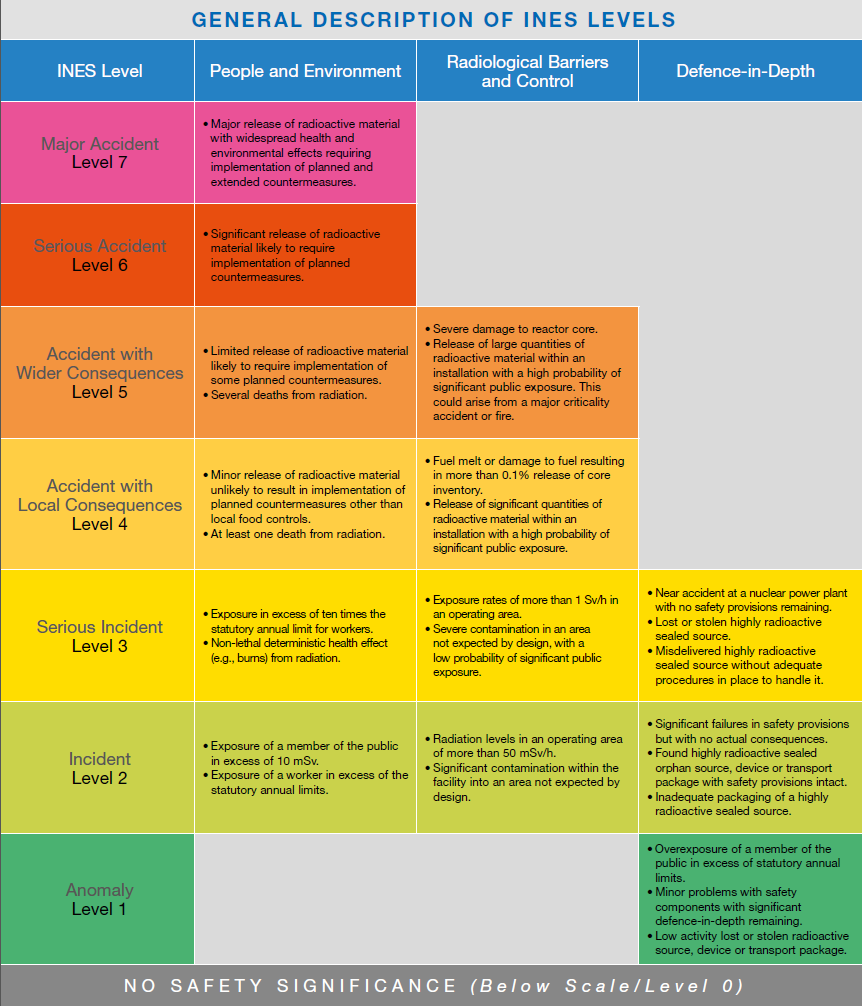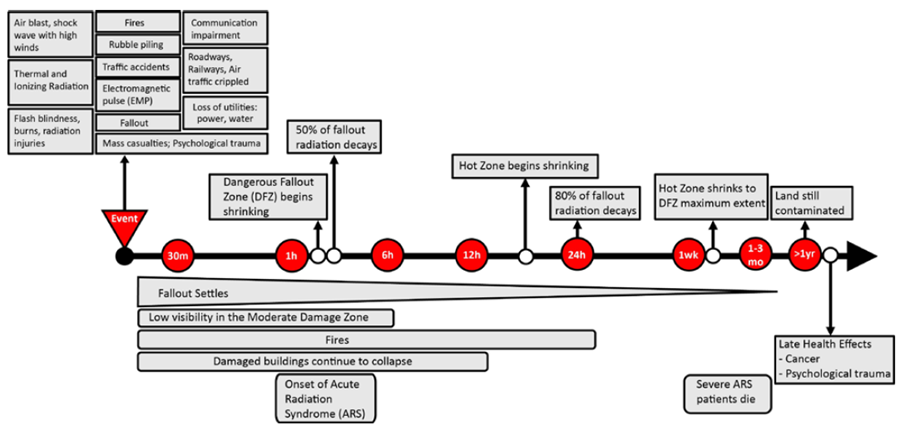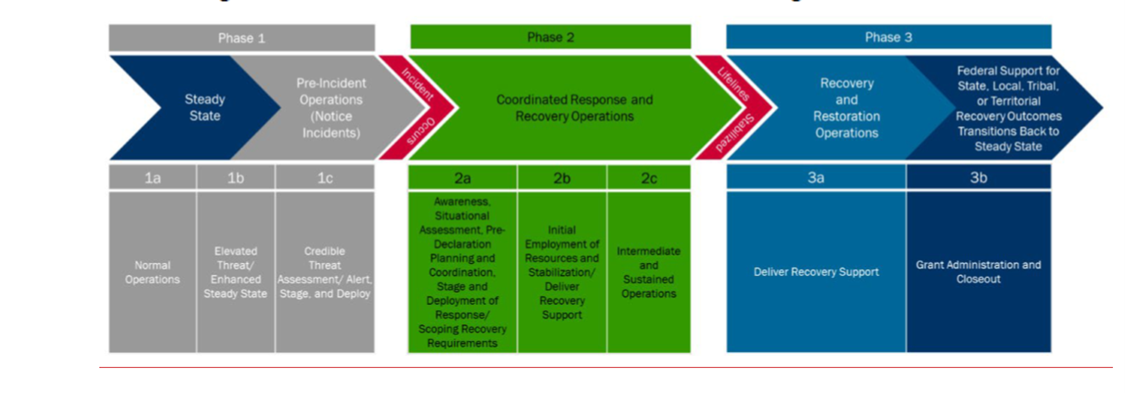Terminology to Describe Radiation Incidents
- Key definitions: incident vs. event
- International Nuclear and Radiological "Event" (Severity) Scale (INES)
- Incident's Phases and Timelines
Key definitions: incident vs. event
What is the difference between an event and an incident using current US terminology?
-
Event (planned event)
- Examples: a scheduled nonemergency activity (e.g., sporting event, concert, parade, training exercise, large convention, fair, large gathering, etc.)
-
Incident (unplanned event)
- Examples: An occurrence or event, natural or manmade that requires a response to protect life or property. Incidents can include major disasters, emergencies, terrorist attacks, terrorist threats, civil unrest, wild land and urban fires, floods, hazardous materials spills, nuclear accidents, aircraft accidents, earthquakes, hurricanes, tornadoes, tropical storms, tsunamis, war-related disasters, public health and medical emergencies, and other occurrences requiring an emergency response.
- Source: Introduction to the Incident Command System (ICS 100.c), Student Manual, November 2018, (PDF - 8.99 MB). See glossary. This is part of the National Incident Management System (NIMS).
International Nuclear and Radiological "Event" (Severity) Scale (INES)
- Developed by International Atomic Energy Agency (IAEA) and partners in 1990 and it has undergone revisions.
- The diagram below is the current version.
- Severity scale ranges from 1 (least severe) to 7 (most severe)
- The severity of an event is about 10 times greater for each increase in level on this scale.
- Events without safety significance are called "deviations" and are classified as Below Scale/Level 0.
-
See INES information
-
Overview
with diagram
- INES Brochure (PDF - 189 KB)
-
INES Flyer
(PDF - 357 KB)


Source of Table above: IAEA flyer
-
Overview
with diagram
-
Note nomenclature difference between IAEA and US
- IAEA nomenclature references "event".
- US nomenclature references "incident" as in the NIMS.
-
Examples
- IAEA characterized the March 2011 Fukushima Nuclear Accident in Japan as an INES Level 7 accident
- IAEA characterized the 1986 Chernobyl nuclear reactor accident in the Ukraine as an INES Level 7 accident.
Incident's Phases and Timelines
- "Nuclear/Radiological Incident Annex to the Response and Recovery Federal Interagency Operations Plans" (PDF - 3.38 MB) (US Government Interagency, May 2023) describes 3 main operational phases for the response to and recovery from a nuclear/radiological incident.
- The phases vary based upon the size, scope, and complexity of the incident.
- The operational phases identified in the Response and Recovery Federal Interagency Operations Plans serve as the default posture for achieving Nuclear/Radiological Incident Annex response and recovery objectives.
- Catastrophic nuclear/radiological incident response and recovery activities are interdependent and often concurrent.
- Decisions made and priorities set early in the response will have a cascading effect on the nature and speed of recovery
-
Figure 3 from that document, shown below, provides an
overview of this default posture.
-
Expected Timeline of effects of a 10-Kiloton Improvised
Nuclear Device Detonation

- The graphic above is from the 2016 version of the Nuclear/Radiological Incident Annex to the Response and Recovery Federal Interagency Operations Plan (PDF - 3.38 MB) (See Appendix 1 to Branch 1, page 26) (US Government Interagency, October 2016)
- Note: The Nuclear/Radiological Incident Annex was updated in 2023 . The 2023 version does not contain an equivalent timeline of expected effects of a 10-kt Improvised Nuclear Device Detonation.
- The text after the graphic in the 2016 Annex explains the terms in the graphic.
-
The
EPA PAG Manual 2017
says that emergency planners divide responses to
radiological incidents into three phases of activity.
- Early Phase - The beginning of a radiological incident for which immediate decisions for effective use of protective actions are required and must therefore be based primarily on the status of the radiological incident and the prognosis for worsening conditions. When available, predictions of radiological conditions in the environment based on the condition of the source or actual environmental measurements may be used. Protective actions based on the PAGs may be preceded by precautionary actions during the period. This phase may last from hours to days.
- Intermediate Phase - The period beginning after the source and releases have been brought under control (has not necessarily stopped but is no longer growing) and reliable environmental measurements are available for use as a basis for decisions on protective actions and extending until these additional protective actions are no longer needed. This phase may overlap the early phase and late phase and may last from weeks to months.
- Late Phase - The period beginning when recovery actions designed to reduce radiation levels in the environment to acceptable levels are commenced and ending when all recovery actions have been completed. This phase may extend from months to years. A PAG level, or dose to avoid, is not appropriate for long-term cleanup.
-
The phases cannot be represented by precise periods of time
– and may even overlap - but to view them in terms of
activities, rather than time spans, can provide a useful
framework for emergency response planning.
- See also: Summary Table for PAGs, Guidelines, and Planning Guidance for Radiological Incidents by Phase of Incident (From 2017 EPA PAG Manual, Table 1-1, page 6)
-
Diagram showing the Recovery Continuum timelines and
tasks
and considerable overlap among recovery tasks during the
short term, intermediate term and long term phases of an
incident.
National Disaster Recovery Framework
(PDF - 11 MB) (DHS/FEMA, September 2011) See page 8, Figure
1.
- The EPA PAG Manual 2017 has a radiation specific update to this recovery framework in Table 4-2, page 50 "Reentry Matrix: Quick Reference to Operational Guides".
- 2008 description of phases of an RDD and IND incident has been superseded by the nomenclature above.


